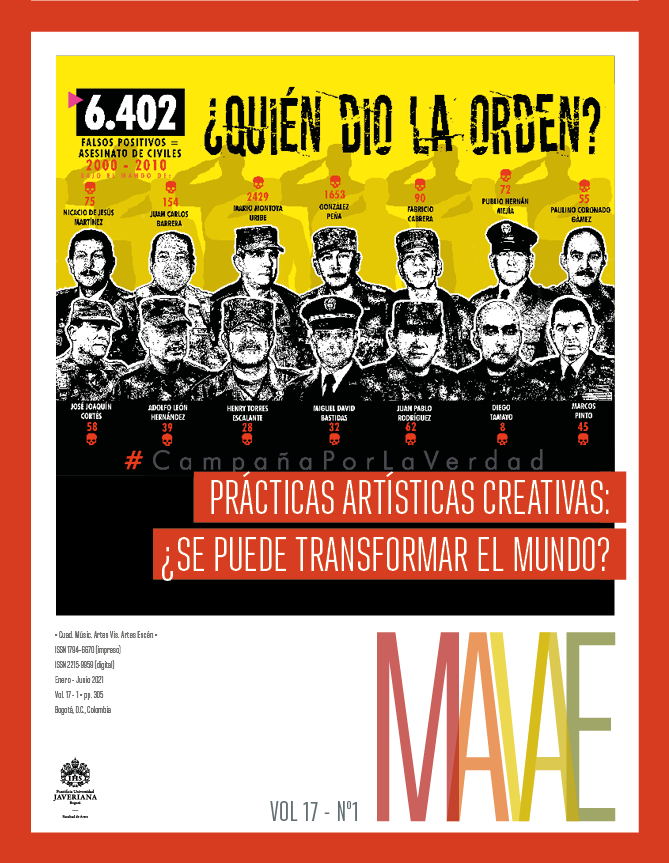Resumen
Las manifestaciones de descontento popular que se han vivido en Colombia entre 2020 y 2021 se han visto determinadas por las restricciones instauradas por el Gobierno para combatir la difusión del covid-19. Ante la dificultad de ocupar el espacio público, la relación entre la ciudadanía y las acciones de protesta se ve obligada a transformarse, en tanto los encuentros fortuitos que caracterizan una ciudad dinámica se reducen a causa de las cuarentenas. En este periodo, han proliferado formas de protesta que involucran distintos niveles de ocupación del espacio público y que han buscado reactivar la calle. Las acciones como pintadas de gran formato y die-ins buscan despertar el sentido de solidaridad y de reactivar las luchas de una población aislada en el espacio privado: gracias a la circulación en redes sociales de imágenes de estas acciones, se busca evocar una relación corporal entre el espectador y el cuerpo al que se alude en la fotografía o video. Así, el límite entre espacio privado y espacio público se desdibuja gracias a la reproducción de fotografías y videos de intervenciones colectivas. Este artículo analizó las potencialidades de estas dos formas de protesta, en particular desde un interés por la relación entre espectador e imagen que estas pueden gestar
Butler, Judith. 2012. “A Politics of the Street.” Peter Wall Institute for Advanced Studies, Vogue Theatre, Vancouver, 24 de mayo. https://www.youtube.com/watch?v=v-bPr7t4tgA.
— 2017. Cuerpos aliados y lucha política. Hacia una teoría performativa de la asamblea. Bogotá: Planeta.
— 2020. “Los poderes de la memoria en las pequeñas cosas”. Museo Nacional Centro de Arte Reina Sofía, conferencia virtual, 20 de diciembre. https:// www.youtube.com/watch?v=YuPj_1pv6UA.
Cartel Urbano. 2021. “¿De quién es la calle? Pintura callejera y censura en el paro nacional”. https://cartelurbano.com/historias/de-quien-es-lacalle-pintura-callejera-y-censura-en-el-paro-nacional.
CNMH (Centro Nacional de Memoria Histórica). 2018. Desaparición forzada: Balance de la contribución del CNMH al esclarecimiento histórico. Bogotá: CNMH. https://centrodememoriahistorica.gov.co/desaparicion-forzada-balance-de-la-contribucion-del-cnmh-alesclarecimiento-historico/
Certeau, Michel de. 2000. La invención de lo cotidiano. Vol. 1: Artes de hacer. México: Universidad Iberoamericana.
Deleuze, Gilles. 2007. “What is the Creative Act?” En Two Regimes of Madness: Texts and Interviews 1975-1995, 312-325. Nueva York: Semiotext(e).
El Espectador. 2021. “Mural ‘Estado Asesino’ y otros graffitis que han sido borrados”, 10 de mayo. https://www.elespectador.com/judicial/muralestado-asesino-y-otros-graffitis-que-han-sido-borrados-article/.
El Tiempo. 2021. “El pueblo no se rinde, carajo: Reemplazo de polémico mural en Medellín”, 14 de mayo. https://www.eltiempo.com/colombia/medellin/el-pueblo-no-se-rinde-carajo-reemplazo-depolemico-
mural-en-medellin-588509.
Hirsch, Marianne. 2016. “Vulnerable Times”. En Vulnerability in Resistance, 76-97. Durham: Duke University Press.
Mirzoeff, Nicholas. 2017. The Appearance of Black Lives Matter. Miami: [Name]. https://namepublications.org/item/2017/the-appearance-ofblack-lives-matter/.
Noticias Caracol. 2020. “Bogotá vacía: Así lució en el primer día de cuarentena obligatoria”, 20 de marzo. https://www.youtube.com/watch?v=xvgoBemOEpw.
Ospina, Lucas. 2021. “Destruir el arte: Fin de semana de censura del gobierno Duque en el PARO NACIONAL”. Cerosetenta, 11 de mayo.https://cerosetenta.uniandes.edu.co/destruir-el-arte-fin-de-semanade-censura-del-gobierno-duque-en-el-paro-nacional/.
Phelan, Peggy. 1993. Unmarked: The Politics of Performance. Londres: Routledge.
Saldarriaga Hernández, Mariana. 2020. “#NOSESTÁNMATANDO: Un mural en 10 ciudades”. Cerosetenta, 6 de noviembre. https://cerosetenta.uniandes.edu.co/nosestanmatando-un-mural-con-ecoen-10-ciudades/.
Tapia Jáurgui, Tania. 2020. “COVID 19 I El silencio de la cuarentena”.Cerosetenta, 21 de marzo. https://cerosetenta.uniandes.edu.co/elsilencio-de-la-pandemia-cuarentena/.
Turkewitz, Julie. 2020. “Bogotá y el virus: Calles vacías y cacofonía en pausa”. New York Times, 31 de marzo. https://www.nytimes.com/es/2020/03/31/espanol/america-latina/bogotacuarentena-virus.html.
Turkewitz, Julie y Sofía Villamil. 2021. “Colombia Police Respond to Protests With Bullets, and Death Toll Mounts”. New York Times,5 de mayo. https://www.nytimes.com/2021/05/11/learning/
lesson-of-the-day-colombia-police-respond-to-protests-withbullets-and-death-toll-mounts.html.
UBPD (Unidad de Búsqueda de Personas dadas por Desaparecidas). 2021.“Urge dejar de negar la desaparición de personas en las protestas: UBPD”, 28 de mayo. https://www.ubpdbusquedadesaparecidos.
co/actualidad/urge-dejar-de-negar-la-desaparicion-de-personasen-las-protestas-ubpd/.
Zuev, Dennis y Gary Bratchford. 2020. “The Citizen Drone: Protest, Sousveillance and Droneviewing”. Visual Studies 35, n.º 5: 442-456. ttps://doi.org/10.1080/1472586X.2020.1843285.

Esta obra está bajo una licencia internacional Creative Commons Atribución 4.0.
Derechos de autor 2021 Nicole Cartier Barrera


